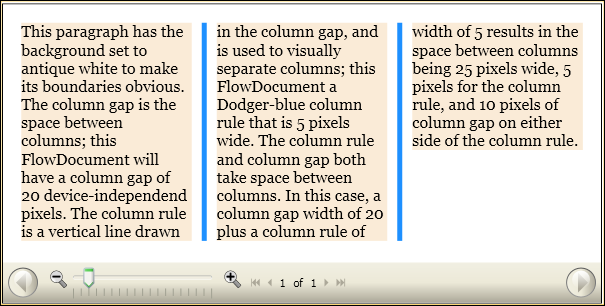Cómo: Usar atributos de separación de columnas de FlowDocument
Este ejemplo muestra cómo utilizar las características de separación de columnas de FlowDocument.
Ejemplo
El siguiente ejemplo define FlowDocument, y establece los atributos ColumnGap, ColumnRuleBrush y ColumnRuleWidth. El FlowDocument contiene un único párrafo de contenido de muestra.
<FlowDocumentReader>
<FlowDocument
ColumnGap="20.0"
ColumnRuleBrush="DodgerBlue"
ColumnRuleWidth="5.0"
ColumnWidth="140.0"
>
<Paragraph Background="AntiqueWhite" TextAlignment="Left">
This paragraph has the background set to antique white to make its
boundaries obvious.
The column gap is the space between columns; this FlowDocument will
have a column gap of 20 device-independend pixels. The column rule
is a vertical line drawn in the column gap, and is used to visually
separate columns; this FlowDocument a Dodger-blue column rule that
is 5 pixels wide.
The column rule and column gap both take space between columns. In
this case, a column gap width of 20 plus a column rule of width of 5
results in the space between columns being 25 pixels wide, 5 pixels
for the column rule, and 10 pixels of column gap on either side of the column rule.
</Paragraph>
</FlowDocument>
</FlowDocumentReader>
La siguiente figura muestra los efectos de los atributos ColumnGap, ColumnRuleBrush y ColumnRuleWidth en un FlowDocument representado.
 Captura de pantalla que muestra el atributo Intra Column de FlowDocument.
Captura de pantalla que muestra el atributo Intra Column de FlowDocument.
Colaborar con nosotros en GitHub
El origen de este contenido se puede encontrar en GitHub, donde también puede crear y revisar problemas y solicitudes de incorporación de cambios. Para más información, consulte nuestra guía para colaboradores.
.NET Desktop feedback
